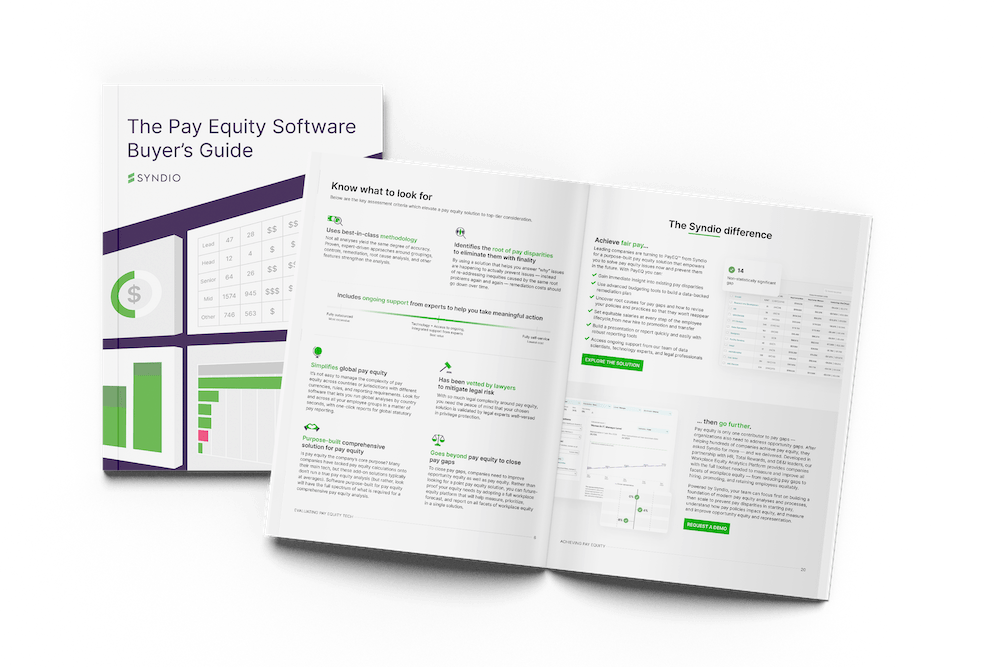The Pay Equity Software Buyer’s Guide
This buyer’s guide is designed to help HR and Total Rewards/Compensation decision makers evaluate pay equity tech options by providing a comprehensive overview of assessment criteria and key features.

In this guide:
Pay equity has become a must-have
90% of companies have conducted a pay equity analysis at some point.
Pay equity is shifting to ongoing management
50% of organizations now conduct pay equity analyses more frequently than annually.
Syndio | 2023 Workplace Equity Trends Report
Want to download this Buyer's Guide as a PDF?
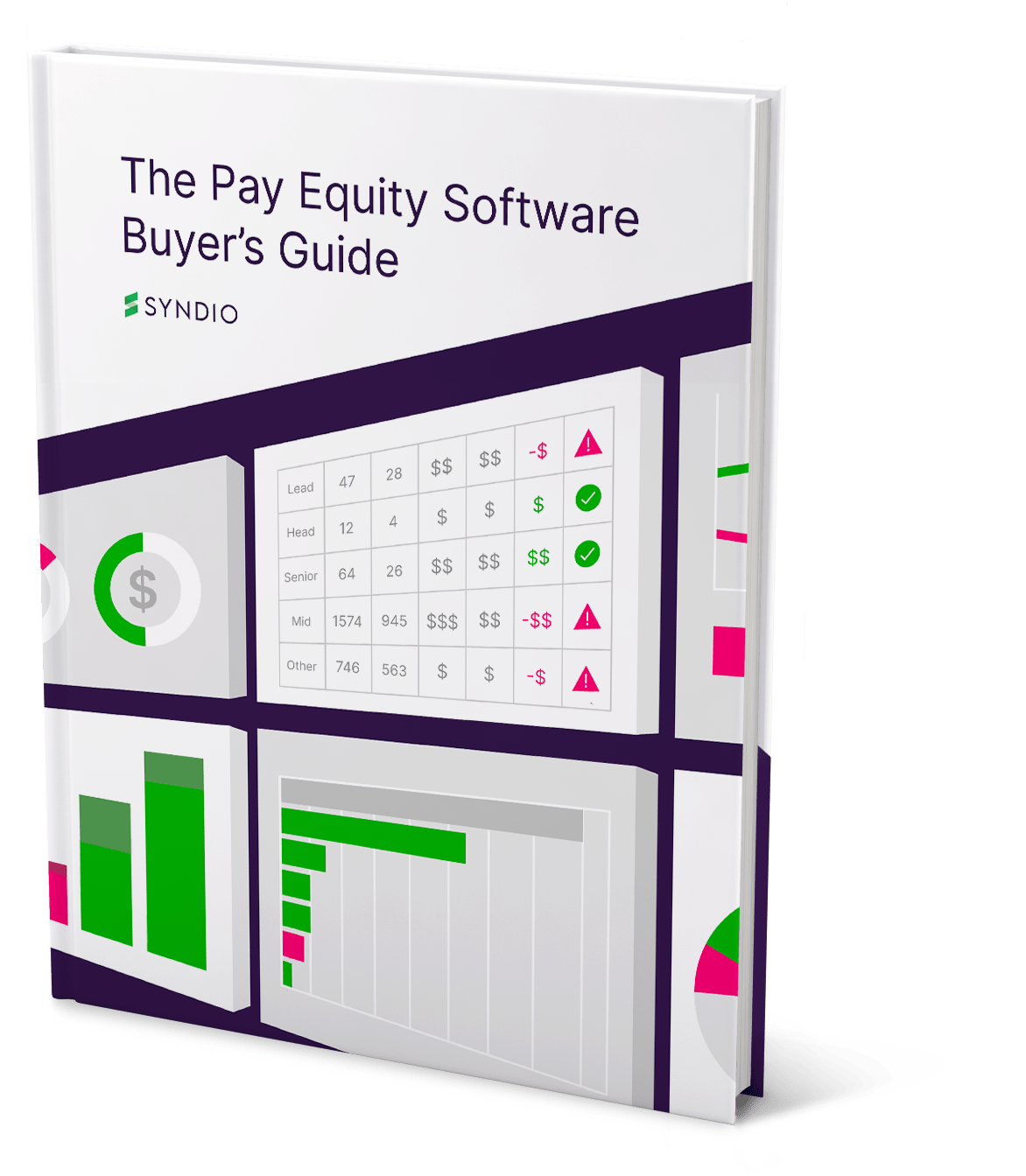
Want to download this Buyer's Guide as a PDF?
Pay equity matters more than ever — but it’s also more complicated than ever.
In the transparency era, pay equity is no longer optional — and the need for consistent and continuous pay explainability has entered the compensation conversation.
The urgency to get pay equity right has never been greater as the transparency era brings pay into the open. Companies must comply with new and emerging laws and address practical considerations such as geo-differentials, compression, and competitiveness, all while facing pressure from investors to track social issues in their ESG framework. And, as pay is laid bare for all to see and employees start asking tough questions about their pay, organizations must be able to clearly articulate how they determine pay, how they apply pay policies to individual employees, and whether pay decisions are equitable and consistent: an emerging business mandate known as “pay explainability.” A once a year analysis does not answer these questions for you — you need always-on software to check and adjust your assumptions as employees continue to enter and exit your company. Ensuring pay equity — and communicating about pay clearly — is no longer just an ethical imperative but a business necessity.
Pay equity software has emerged as a powerful tool for companies seeking digital transformation to more efficiently maintain pay equity in an ongoing way.
Leading companies are leaving behind the annual “pay audit” mindset for a year-round equitable pay management approach aimed at preventing issues. This shift is driven by the recognition that pay equity is not a one-time problem to be fixed, but rather an ongoing challenge that requires continuous attention. However, in a slowing economy, resources are tighter than ever for most HR and Compensation teams, making efficiency a key focus. The traditional approach of outsourcing annual pay equity analyses to law firms and consultants is too slow and retroactive to keep up with increasing transparency demands. Pay equity software can help companies devote fewer resources and less time to analyses through automation, as well as reducing remediation costs over time. By using pay equity tech to gain data-driven insights and continuously monitor their progress, organizations can more effectively reduce compliance risk, keep up with changing legislation, and embed equity into everyday pay decisions. This also fosters a culture of transparency which helps build trust and improve retention. As we move into an era of increased scrutiny around compensation practices, pay equity software is poised to become a critical tool for any company looking to stay ahead of the curve
But not all tech is created equal.
There’s a lot of noise in the pay equity software arena that can make it difficult to determine the optimal solution for your organization’s needs. Additionally, while many companies are leaving behind slow pay equity analyses conducted via consultant and law firms, they aren’t quite ready for a fully self-service, hands-off solution due to the complexities and pressures involved. The best value of both worlds is a vendor who offers a balance of user-friendly software backed by best-in–class methodology with ongoing access to expert advice and guidance.
Who this guide is for
- Total Rewards/Compensation professionals
- CHROs
- People/Workforce Analytics professionals
- HR tech buyers
- Corporate Communications professionals
Questions we’ll answer
- What are key criteria for selecting pay equity technology?
- Who should be involved in the evaluation and decision process?
- How to ensure buy-in and overcome internal objections to investing in pay equity software?
"After two years of using Syndio, we have no more statistical pay gaps based on race, gender, or age. Syndio has helped us achieve this outcome."
Senior Director, Total Rewards
01
Evaluating pay equity tech
- Know what to look for
- Ask the right questions
Know what to look for
Below are the key assessment criteria which elevate a pay equity solution to top-tier consideration.
Uses best-in-class methodology
Not all analyses yield the same degree of accuracy. Proven, expert-driven approaches around groupings, controls, remediation, root cause analysis, and other features strengthen the analysis.
Identifies the root of pay disparities to eliminate them with finality
Not all analyses yield the same degree of accuracy. Proven, expert-driven approaches around groupings, controls, remediation, root cause analysis, and other features strengthen the analysis.
Includes ongoing support from experts to help you take meaningful action
Goes beyond pay equity to close pay gaps
With so much legal complexity around pay equity, you need the peace of mind that your chosen solution is validated by legal experts well-versed in privilege protection.
Has been vetted by lawyers to mitigate legal risk
With so much legal complexity around pay equity, you need the peace of mind that your chosen solution is validated by legal experts well-versed in privilege protection.
Simplifies global pay equity
It’s not easy to manage the complexity of pay equity across countries or jurisdictions with different currencies, rules, and reporting requirements. Look for software that lets you run global analyses by country and across all your employee groups in a matter of seconds, with one-click reports for global statutory pay reporting.
Purpose-built comprehensive solution for pay equity
Is pay equity the company’s core purpose? Many companies have tacked pay equity calculations onto their main tech, but these add-on solutions typically don’t run a true pay equity analysis (but rather, look at averages). Software purpose-built for pay equity will have the full spectrum of what is required for a comprehensive pay equity analysis.
Ask the right questions
Most pay equity tech can tell you what pay disparities you have and who they impact, but fail to pinpoint why those disparities are happening in the first place. Learn the features and capabilities you should prioritize to ensure you get maximum value out of your investment.
01 Streamlined data management
02Efficiency and ease of use
03Comprehensive analyses
04Customizable analyses
05Scalable to full global analyses
06Tailored remediation recommendations
07Robust reporting tools and services
08Included support and expertise
09Validated legal compliance
10Powerful root cause prevention
11Highest levels of data security
12Smooth implementation, adoption, and customer experience
13Credible customer roster
14Capabilities to advance your equity journey beyond pay
02
Selection toolkit
- Who to involve
- Evaluation checklist
- Objection handling
- Product scorecard
- RFP template
Who to involve
Pay equity used to be thought of as the domain of legal teams and Compensation professionals. But as fair pay becomes a strategic priority for human capital, investor relations, and even brand considerations, this attitude is shifting. Pay equity now touches stakeholders and responsibilities across the company. The first step in finding the right pay equity provider is to bring together a cross-functional team, including leaders from Compensation/Total Rewards, Human Resources, People Analytics, Talent Management, DE&I, Legal (internal or third-party), and IT in order to achieve consensus and buy-in, align overlapping priorities, centralize efforts, and coordinate communications.
Evaluation checklist
Below are steps for making an informed decision about which type of pay equity technology is right for your organization.
Identify champions and stakeholders in your organization who will need to be consulted during the decision phase.
Who should be involved in demos?
Who should be presented with the evaluation recommendations?
Whose approvals are needed and who has final decision-making authority?
Establish timelines and budget.
When do you need to decide on a tool?
When do you need the tool implemented with the relevant team onboarded
When do you need to conduct your first pay equity analysis with the tool?
Develop a list of internal needs and priorities.
What is your main goal in purchasing pay equity software?
What are your major pain points with your current approach to pay equity?
What are your capability gaps around pay equity?
What are key priorities and must-have features? What are nice-to-have features?
Create a list of questions to ask (See pages 7-9 above for recommendations)
Research vendors online to narrow down to a short-list.
Review online tech ratings
Review their online product content
Note their public customer list
Read case studies
Contact short-listed companies for demos and references (and/or develop RFP if needed for your procurement process).
Schedule and attend demos
Collect and review customer references
Ask questions during and after demos (See the "Ask the right questions" section on pages 7-9 above or check out 25 Questions to Ask When Evaluating Pay Equity Tech)
Score vendors based on your evaluation criteria.
Use an evaluation scorecard (Download Syndio's Pay Equity Software Evaluation Scorecard here)
Decide and get buy-in on a solution.
Present evaluation recommendations to stakeholders
Arrive on a consensus
Move forward with purchasing, implementation, and adoption
Identify champions and stakeholders in your organization who will need to be consulted during the decision phase.
Who should be involved in demos?
Who should be presented with the evaluation recommendations?
Whose approvals are needed and who has final decision-making authority?
Establish timelines and budget.
When do you need to decide on a tool?
When do you need the tool implemented with the relevant team onboarded
When do you need to conduct your first pay equity analysis with the tool?
Develop a list of internal needs and priorities.
What is your main goal in purchasing pay equity software?
What are your major pain points with your current approach to pay equity?
What are your capability gaps around pay equity?
What are key priorities and must-have features? What are nice-to-have features?
Create a list of questions to ask (See pages 7-9 above for recommendations)
Research vendors online to narrow down to a short-list.
Review online tech ratings
Review their online product content
Note their public customer list
Read case studies
Contact short-listed companies for demos and references (and/or develop RFP if needed for your procurement process).
Schedule and attend demos
Collect and review customer references
Ask questions during and after demos (See the "Ask the right questions" section on pages 7-9 above or check out 25 Questions to Ask When Evaluating Pay Equity Tech)
Score vendors based on your evaluation criteria.
Use an evaluation scorecard (Download Syndio's Pay Equity Software Evaluation Scorecard here)
Decide and get buy-in on a solution.
Present evaluation recommendations to stakeholders
Arrive on a consensus
Move forward with purchasing, implementation, and adoption
Overcoming objections to get internal buy-in
Under current economic constraints, internal objections to investing in pay equity software can be a significant hurdle. Despite the proven long-term benefits of addressing pay inequity and achieving equal pay, some leaders may perceive it as a “nice-to-have” rather than a priority, or they may feel that resources are better spent elsewhere. However, investing in a pay equity solution is an essential step for companies looking to remain competitive and committed to workplace fairness. Here are some tips for overcoming internal objections.
Calculate the cost of your current system/process and annual remediation cost and compare to projected savings in time, resources, and lowered remediation costs with new software.
Remember, cheaper solutions that can't scale or don't meet all of your needs will only create more costs down the road. "Good enough" isn't good enough when failure to ensure pay equity means the potential for lawsuits. Inequity in the workplace also creates hidden costs in lost productivity and the cost to replace employees by contributing to decreased employee engagement and retention.
Workers are six times more impacted by pay equity than they are by level of pay. In other words, if you want to properly allocate budgets, fix the disparities in pay before you give everyone a raise.
Josh Bersin • Global HR analyst | Predictions for 2023: Redefining Work, The Workforce, and HR, January 2023
Today, Salesforce resolves pay disparities annually. And while total remediation hovers around $3 million a year, they have roughly tripled their employee base since their first analysis. This means the average [remediation] cost per employee has decreased year over year. Dunlap attributes this to the fact that when they correct compensation for an individual, it stays corrected.
Supporting proof points
Employees who perceive their pay as inequitable:

Have a 15% lower intent to stay with their employer than employees who perceive their pay as equitable

Are 13% less engaged at work than employees who perceive their pay as equitable
When orgs educate employees about how pay is determined:

Employee trust in the organization increases by 10%

Pay equity perceptions increase by 11%

The average increase in cost for every year a business waits, or fails, to close role to role gender gaps is $444,368

Companies that disclose they’ve conducted a pay equity analysis report nearly 8% higher mean five-year Return-on-Equity

Employees who perceive a pay gap (regardless of if the pay gap actually exists) experience a 16% decrease in intent to stay at their company
Recent pay equity and gender discrimination settlement have landed at $100M, $118M, and $175M
Evaluation tools
Not sure where to start?
-->
Download the pay equity software evaluation scorecard
Once you have your short-list of vendors, use this scorecard to refine your assessments of each in comparison to each other.
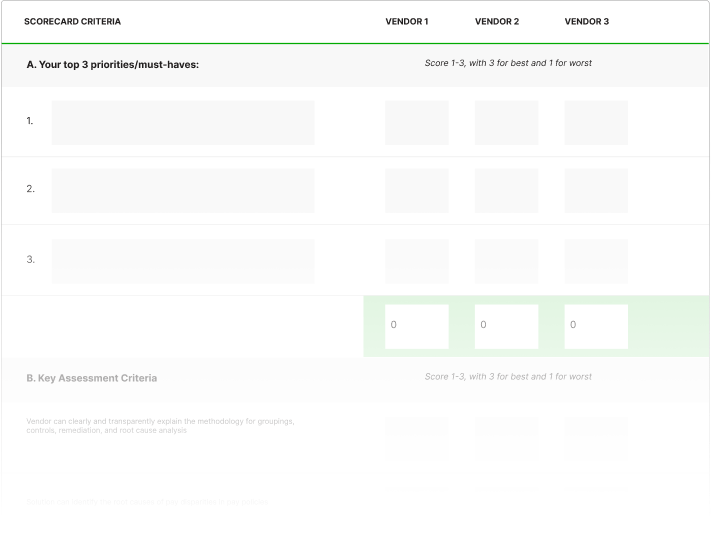
Does your company require a request for proposal (RFP) for software investments?
-->
Get the pay equity software RFP template
To help you target the right questions that reveal a vendor’s true capabilities and potential, we’ve compiled a template based on the questions we most often receive from pay equity software buyers. Don’t miss any make-or-break questions — download our battle-tested RFP template spreadsheet at the link below.
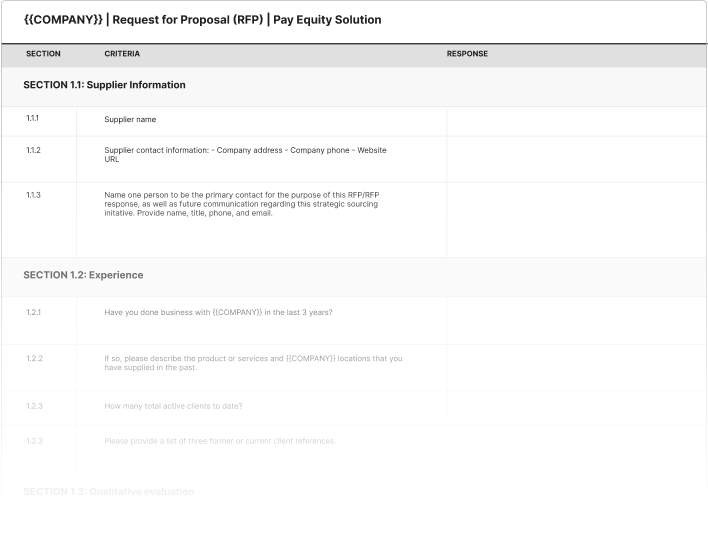
03
Achieving pay equity
- The Syndio difference
- Validate your pay equity approach
The Syndio difference
Achieve fair pay…
Leading companies are turning to PayEQ® from Syndio for a purpose-built pay equity solution that empowers you to solve pay equity issues now and prevent them in the future. With PayEQ you can:
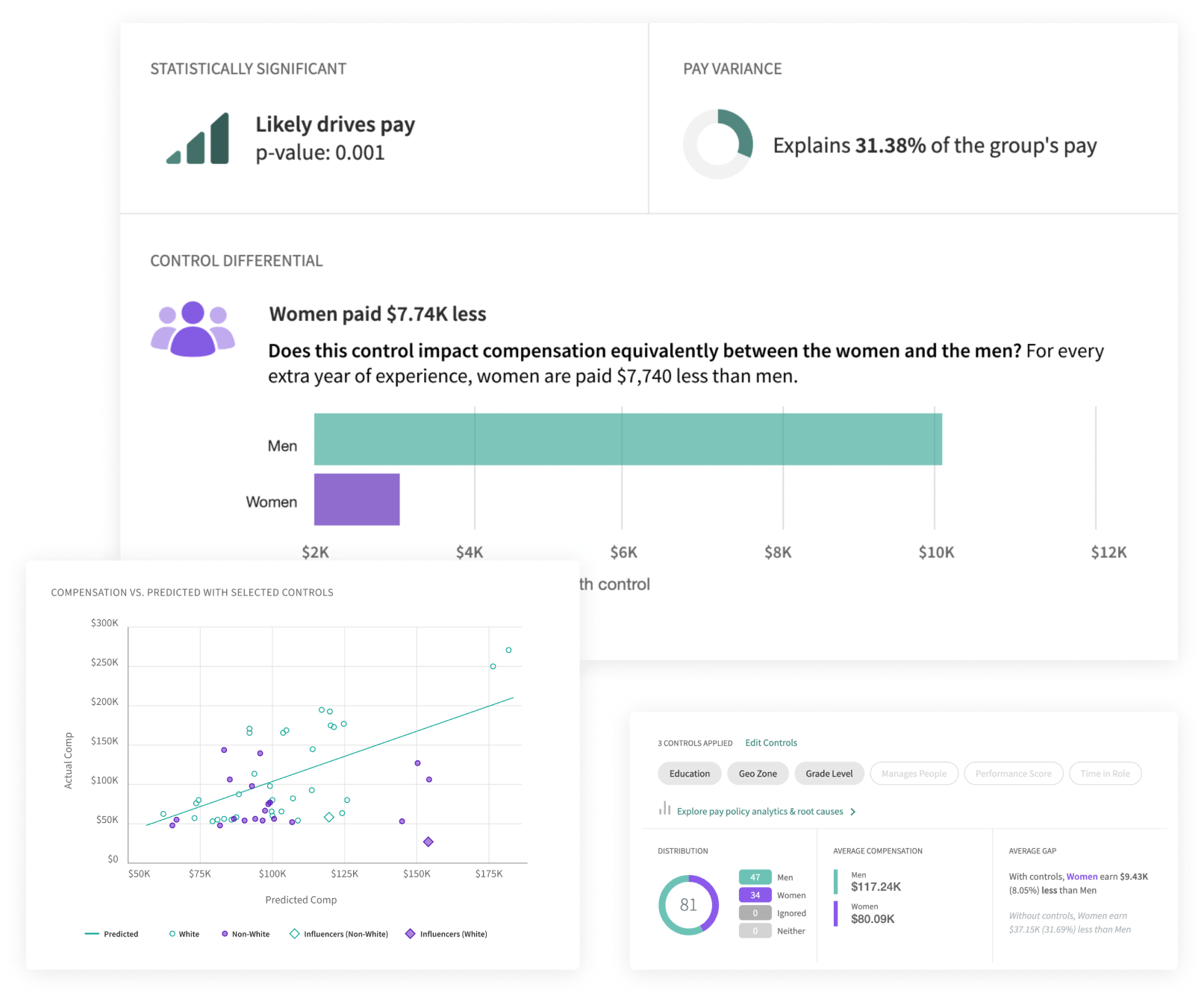
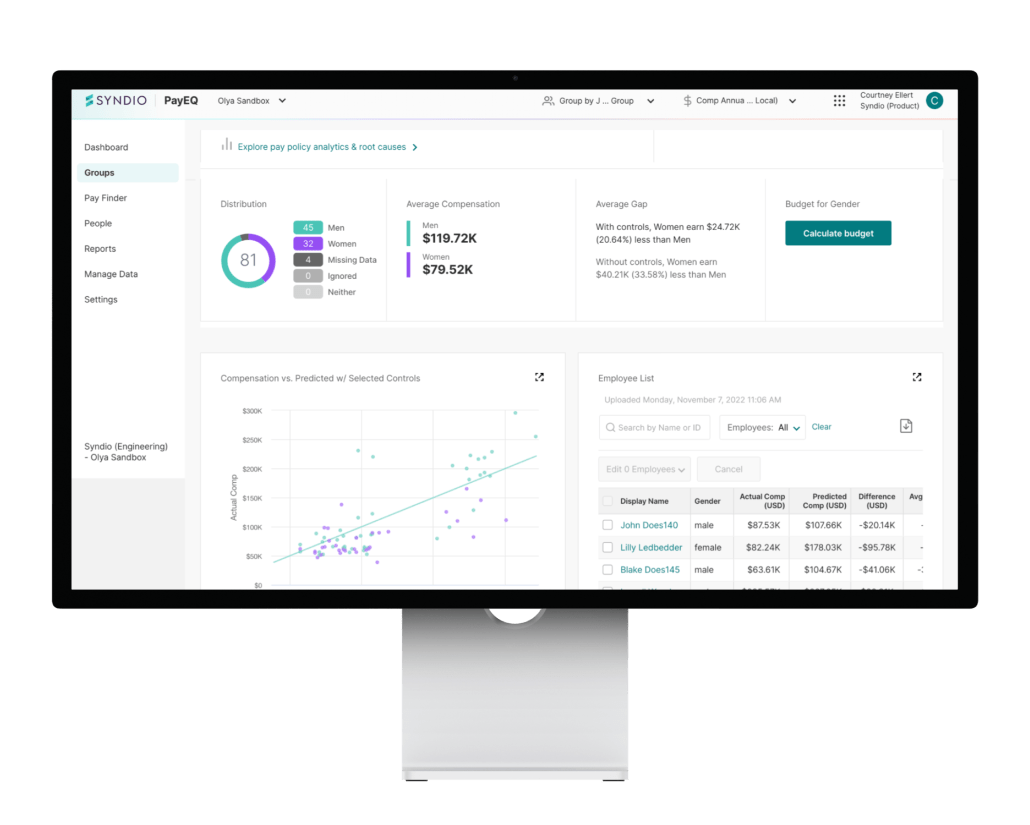
...then go further.
Pay equity is only one contributor to pay gaps — organizations also need to address opportunity gaps. After helping hundreds of companies achieve pay equity, they asked Syndio for more — and we delivered.
Developed in partnership with HR, Total Rewards, and Talent Management leaders, our Workplace Equity Analytics Platform provides companies with the full toolset needed to measure and improve all facets of workplace equity — from reducing pay gaps to hiring, promoting, and retaining employees equitably.
Powered by Syndio, your team can focus first on building a foundation of modern pay equity analyses and processes, then scale to prevent pay disparities in starting pay, understand how pay policies impact equity, and measure and improve opportunity equity and representation.
17%
decrease in annual pay equity remediation cost for repeat users
320+
customers
80
world-class NPS rating*
*The average NPS for a software company is 41
30%
of Fortune’s Most Admired Companies
100+
countries represented in our customers’ analyses
10.5M
employees’ data analyzed
What our customers say
"Syndio’s client and domain expert personnel are superb. The interface and the functionality of the tool is really excellent. Companies like Syndio are blazing a trail for pay equity automation."
EXECUTIVE COMPENSATION LEADER
What experts say
"What [Syndio is] doing — which is very pioneering — is giving leaders and HR departments near real-time data on the equity implications of every pay, reward, hiring, and promotion decision.”
Josh Bersin • Global HR analyst | Predictions for 2023: Redefining Work, The Workforce, and HR, January 2023
Get Fair Pay Workplace certified
Validate your pay equity approach
Fair Pay Workplace is a nonprofit that validates companies after rigorous evaluation of their pay data and practices. To help standardize the way that companies measure pay and promote transparency, Fair Pay Workplace established and upholds a set of Rules & Standards built by an alliance of experts to ensure that when companies claim achievement of pay equity, they are backed by sound methodologies and accepted best practices.
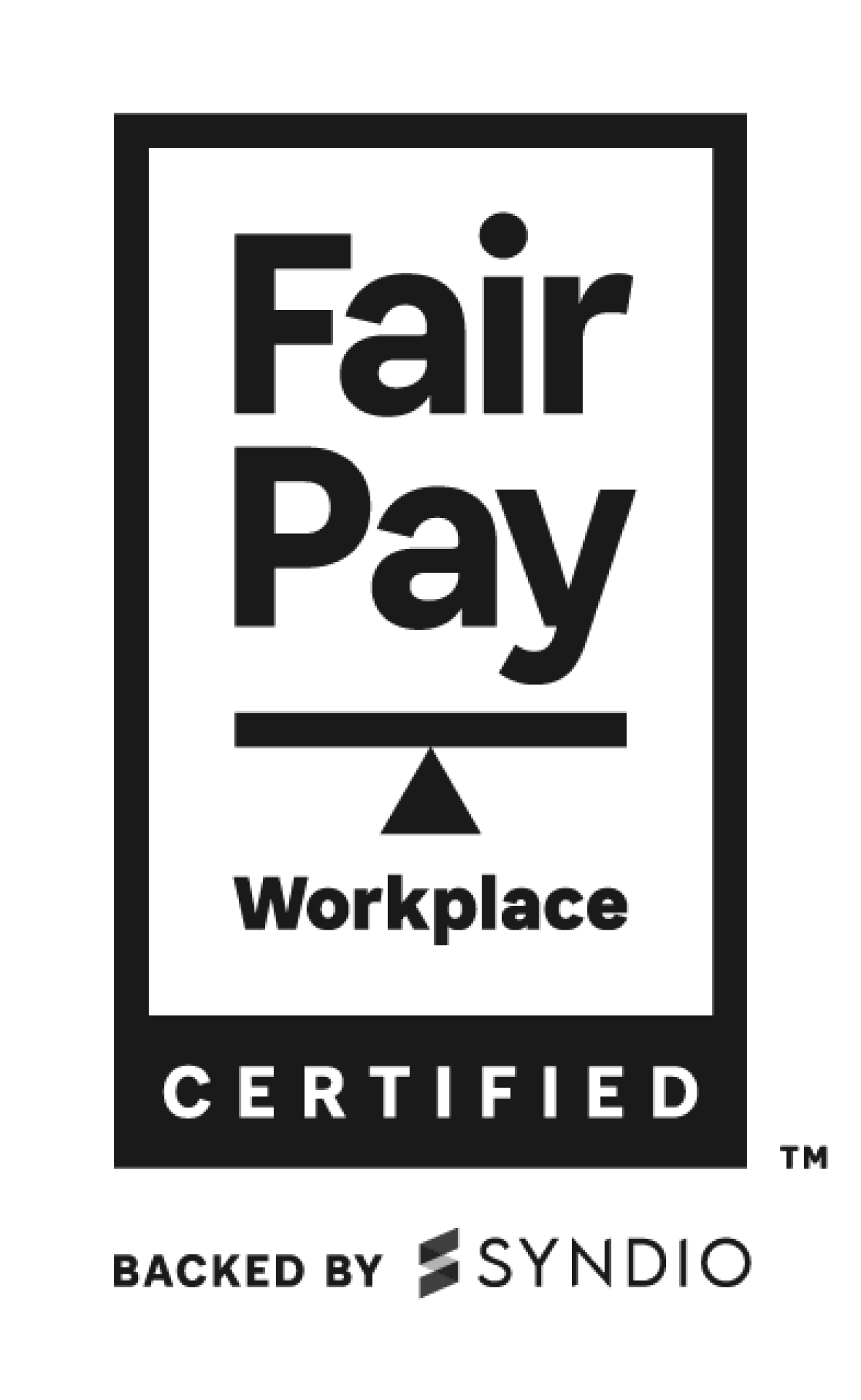
04
Maximize your pay equity investment
- Key recommendations
- Future outlook
Go deeper into pay — then go further
Key recommendations for buyers
Find a solution that can tell you the why, not just the what.
Defending your pay equity analysis process with “We use tech” is insufficient for something as complex and important as pay equity. The risks associated with potential legal ramifications, transparency legislation, and employee/investor relations require a trusted, credible solution backed by sound methodology. This means investing in a tool that is validated by legal experts, is purpose-built for pay equity, includes ongoing expert support, and tackles problems at their root.
Future outlook
Pay equity is the starting point for a holistic workplace equity program.
As the spotlight shines on pay equity in the era of transparency, the need for pay explainability has emerged as an urgent requirement for every employer. But once employees understand their pay structure, they start asking more challenging questions about how to progress to higher-paying roles and why others are advancing before them. Additionally, even as companies solve pay equity, their pay gap can remain difficult to budge due to its roots in opportunity and representation inequities. All of this makes pay equity the onramp to a broader requirement: workplace equity.
Leading companies are starting to evaluate workplace equity holistically in order to more effectively address their pay gaps. Pay equity point solutions will be left behind in favor of a comprehensive workplace equity analytics platform that can measure and measure and improve all facets of workplace equity — from reducing pay gaps to hiring, promoting, and retaining employees equitably.
New to pay equity and software evaluations? Here is a glossary of terms to get you started.

